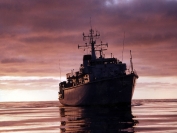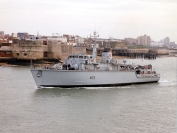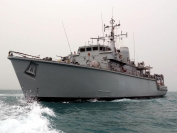Mine Warfare, Diving, Fishery Protection And Patrol Boat Squadrons
The Mine Warfare, Diving, Fishery Protection and Patrol Boat (MFP) arm of the Royal Navy is headed by Captain (MFP). He is responsible for the operational capability of an on call Mine Warfare Force and is the specialist advisor on diving, fishery protection and patrol boat services to the Chief of Staff (Warfare) to Commander in Chief Fleet.
The Mine Warfare Diving and Fishery Protection arm of the Royal Navy is divided into two distinct areas; Mine Warfare and Diving and Fishery Protection and Patrol Boats. The Mine Warfare force has three individual Squadrons, First Mine Countermeasures, Second Mine Countermeasures and Third Mine Countermeasures Squadrons each headed by a Commander. Similarly, the Diving, Fishery Protection and Patrol Boat forces have their own individual Squadron Commanders. It is Captain (MFP)'s responsibility to ensure that all arms of the service are at their maximum effectiveness and are available for tasking within their operational notice to an incident anywhere in the world.
Mine Countermeasures
The task of keeping ports and coastal shipping lanes free from the threat of mining is an essential part of successful maritime operations. For that the Royal Navy has a fleet of mine countermeasures vessels.
Modern mines can be triggered not only by collision but also by the sound of the ship passing through the water or by the magnetic signature of the ship's hull, which means modern mine countermeasures vessels have to be very sophisticated. Every effort is made to reduce the magnetic signatures of the ships, the hulls are made from glass reinforced plastic rather than steel and even the buckets on board have to be made from non-magnetic materials.
Modern MCMVs have added high definition sonar and unmanned submersibles to traditional "sweep gear" that trails in the water. The sonar can find mines on the seabed or in mid-water by bouncing high frequency sound waves off them. The submersibles are then guided to the mine and destroy it using a high explosive charge.
The Royal Navy's MCMVs are divided into 3 squadrons, two based in Portsmouth and one in Faslane. The squadron staffs split their time between their base ports and deployments.


